THE POWER-GRID OSCILLATOR
The complete causes of the 1965 and 2003 northeast US blackouts continue to be a mystery to most engineers. In both
cases, no damage capable of causing the blackout was found, and the records of the event reveal little. The underlying
cause may be an inherent part of the system that has been overlooked. Here is a theory that could explain how a large
power grid can suddenly fail with no apparent damage and no discernible cause: The power grid itself may at times act
like a huge oscillator.
AN OVERVIEW OF POWER GRIDS
A power grid is a set of many power generators, interconnected by many power transmission lines, and serving many
power substations (which take power from the grid and deliver it to customers). Each generator can be connected to and
disconnected from different power feeds to different parts of the grid. The power transmission lines can be connected and
disconnected by remote control, to control the direction power is sent within the grid. And some substations have switches
that allow them to take power from one part of a grid or another. Sensors monitor how much power is flowing over each
transmission line, and relay that information to power controllers, or to their computers.
Whenever two or more generators are connected to the same power distribution lines, a way to keep the generators in
synchronization with each other is necessary, to keep the generators from going out of phase with each other and burning
things up. This is usually in the form of devices that compare the phase angle between the generator's voltage output
and its current flow. If the phase angle exceeds 5 degrees, the generator's controller increases or decreases the
setting of how much power is sent to the generator. In a hydroelectric system, the gates controlling the flow of water
are moved slightly. In a steam plant, the steam valve is opened or closed a little. And in a diesel plant, the throttles
on the diesel engines are moved. This changes the speed of the generator's rotation enough to get it back in phase. But
this change takes time, and as I will show, that amount of time taken can lead to trouble.
Generators and power lines have safety systems designed to prevent destruction of the equipment if something goes
wrong. If the current coming from a generator is too high, or if the current on a power line is too high, safety
cutouts disconnect the threatened device before it self-destructs. Safety cutouts also disconnect a piece of equipment
that is operating out of phase with the other devices on the lines. Usually the safety point for a phase shift between
current and voltage is about 20 degrees. If the phase shift is larger than that, the cutout disconnects the equipment
to protect it.
End user equipment that is inductive in nature, particularly very large electric motors, also cause phase shifts.
This, if not counteracted, can cause a power system to ride near its phase-shift trip point. To prevent this, power
companies install large capacitors on power lines leading to sites with large inductive loads. But the capacitors are not
added and removed as the load starts and stops. Also, when a large motor starts, it creates a greater phase shift than it
does when it is running. These factors can also come into play in causing trouble.
All of these different systems are connected together in a power grid, and they can all interact to cause a power
failure. I shall show how, after a little side trip into the world of oscillators.
ABOUT OSCILLATORS
Oscillators are devices that cause repeating motions in mechanical parts, sound waves, or electric currents. Examples
of oscillators include Sterling engines, flutes, pop bottles, cooker relief valves, referee's whistles, and electronic
tone generators. In each case, the same elements are necessary to produce an oscillation:
- A source of power
- An automatic device that releases power
- A feedback loop to control the amount of power released
- A time delay in the feedback loop
Here are some examples of simple oscillators:
|
|
In the case of the flute and the pop bottle, the entire system is powered by moving air. Moving air is introduced
into the system through the hole near one end. This is the power source. The air causes a pressure wave to travel down
the tube, until it encounters the closed end (of the bottle) or an open finger hole (in the flute). The wave then
bounces back toward the air introduction hole. This is the feedback loop, and the time it takes the wave to travel
down the tube and back is the time delay. When the pressure wave reaches the hole where the air is being introduced,
it shoves the air stream aside and exits the hole. This is the device that controls the power. Once the air finishes
bursting from the hole, the cycle repeats. The system oscillates, and produces an audible tone. Thus, we have a simple
oscillator.
|
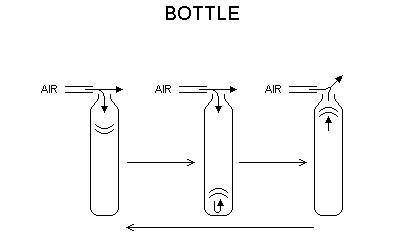
|
|
|
A simple, but hard to start oscillator has a transistor to switch the power on and off, and a series of resistors
and capacitors to delay control of the transistor. A resistor is like a little valve (like on your faucet) that limits
the amount of current that can flow through it. A transistor is like a little automatic valve. When more current flows
through the base terminal, it then lets more current flow through the collector terminal. If less current flows through
the base, then it lets less current flow through the collector. A capacitor is like a little storage tank for
electricity.
Suppose the transistor in our phase shift oscillator starts out in the off position. This means the voltage on the
collector is high (because no current flows through the transistor to lower the voltage). This voltage charges the
capacitors through the resistors. The time it takes to fill up the capacitors causes the delay. When the capacitors
charge up enough, they cause a current to flow through the base of the transistor, causing the transistor to turn on.
But when the transistor turns on, it reduces greatly the voltage on the collector. This discharges the capacitors
through the resistors. After the capacitors discharge enough, the current stops flowing through the base of the
transistor. This turns off the transistor, and the cycle repeats.
|
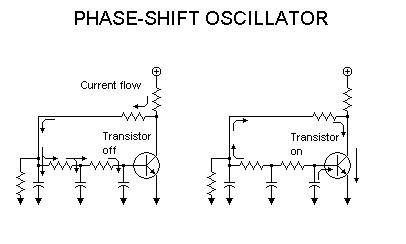
|
|
|
Another oscillator that is much easier to design is the multivibrator. In this circuit, there are two transistors,
and two sets of resistors and capacitors. It is also much easier to understand. Each transistor's collector output is
sent through a capacitor to the base of the other transistor (see diagram 3).
When transistor 1 is off, it sends its high collector voltage to the base of transistor 2 through a capacitor,
turning transistor 2 on. Since transistor 2 is on, its low collector voltage draws current away from the base of
transistor 1, keeping it off. But once the capacitors charge up (the delay), current no longer flows through the base
of transistor 2, and it starts flowing through the base of transistor 1. Transistor 2 shuts off, and transistor 1
turns on. This state persists until the capacitors charge up again in the opposite direction. When this happens,
transistor 1 shuts off and transistor 2 turns on, bringing about the initial state again, and the cycle repeats.
|

|
|
|
There can also be accidental oscillators. Everyone has heard the squawk of feedback when the MC of a convention
brings his microphone too near to the PA speaker. Again we have an oscillator. The power source is in the amplifier.
The amplifier also controls the output of power to the speaker. The sound wave from the speaker, after taking some
time to travel through the air, is picked up by the microphone. The amplifier then takes this sound wave and sends
it to the speaker again. After a delay, it comes to the microphone again, and the cycle repeats. Squeeeeeek!
Another accidental oscillator occurs when power drains in the output section of a stereo amplifier change the
power supply voltage inside a stereo amp (this is not supposed to happen). This change then causes the preamp to
make a voltage output change when no signal is applied to the input. This voltage change is then amplified by the
power amp, causing the power supply voltage to change again. The cycle repeats. Usually the power supply lines in
stereo amplifiers have bypass capacitors on them to prevent changes in the power supply voltage, but if the
capacitors go bad, it causes this problem (which is sometimes called motorboating, due to the sound it makes). In
this case, the feedback occurs through the power supply wiring, an unintended signal path.
|
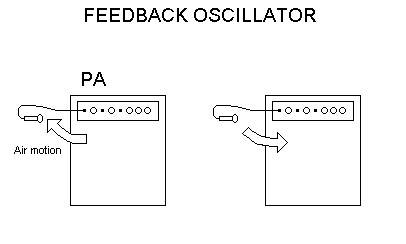
|
|
As we have seen, all oscillators operate using the same basic components of power, a power control, a delay, and
a feedback loop. Now let's see if the same elements can be found in a fluctuating power grid, and if so, whether or not
they can cause oscillation.
A POWER GRID AS AN OSCILLATOR
Normally, a power grid is stable, and does not oscillate of its own accord. But under conditions of overload or
phase shift, conditions can be right for the entire grid to oscillate. Here's how:
- A local overload on one Generator (call it generator 1) can cause it to lag behind, out of phase with the rest of
the generators on the grid. The generators are the power sources.
- The automatic controls on Generator 1 increase the amount of power being fed to the generator from the power
source (steam, diesel, falling water, or nuclear power) to speed it up enough that it gets back into phase. This is the
power control part of the oscillator!
- But those controls take time to act (usually because the controlling servomotors are geared down, and take time to
make the change). This is the delay part of the oscillator!
- Meanwhile, the out of phase Generator 1 has caused a phase shift on the power grid, relative to the output of
another generator (Generator 2) nearby. Generator 2's controls tell it to slow down to get back in phase. This also
takes time to accomplish.
- Generator 1 detects that it is now ahead of phase, because Generator 2 slowed down. It then resets itself to slow
down. This again happens after a delay. We now have feedback taking place!
- Generator 2 now notices that it is behind in phase (because Generator 1 had sped up). Its controls tell it to
speed up.
- Now Generator 1 finds itself behind again, and the cycle repeats.
Note that:
- All of the elements required to cause oscillation are there.
- Similar conditions can occur if a sudden drop in power occurs at a particular point, or if the phase shifts due
to an inductive load starting or stopping.
- If the two plants have different delay times, the oscillations may damp out, or they may become severe.
- A third generator with a different set of delay times can make the power phase oscillations follow an irregular
pattern as it too starts speeding up and slowing down.
- A circular or multiply connected system can cause the same phase shift to approach a generator or transmission line
several times, with different delays, and even with difference in the direction of change. This case produces a very
irregular pattern of leading and lagging phase adjustments.
- Adding equipment to the grid or removing equipment from the grid can change the characteristics of the entire grid,
damping out any oscillations, or enhancing them.
WHY DOESN'T IT HAPPEN ALL THE TIME?
Think of a power grid as a clothesline with several weights hanging by strings attached to it at varying intervals. Now
let's see what happens if we swing one or more of the weights.
|
|
Normally the shifting in phase of one generator is not noticed, because the rest of the grid has so many generators
on it that one can drop out of phase momentarily and correct itself without changing the phase of the grid. Minor
fluctuations usually quickly damp themselves out, because the other generators don't see much of a change when one goes
out of phase.
Swinging one weight on the clothesline causes very little disturbance, because the inertia of the other weights
tends to hold the clothesline in place.
|
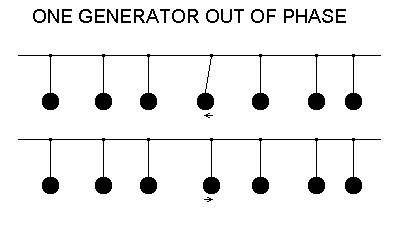
|
|
|
But if power production is near maximum capacity, or if several sets of power transmission lines are out of service,
the remaining parts can resonate at a particular frequency (usually below 1 Hz) and cause oscillations in the power
levels put out by each generator. This is similar to the case where the broken bypass capacitors allowed the oscillation
to travel between different sections of the stereo amplifier through the power supply lines.
If many weights on the clothesline start swinging at once, the whole clothesline starts swinging. Now there is no
reference for each weight to return to rest under, just as there is no reference phase for the generators to get back in
step with. The whole system is oscillating.
|
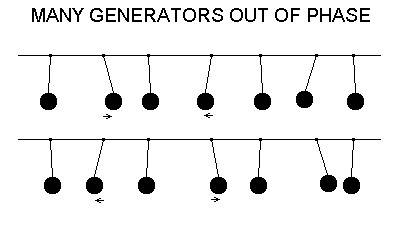
|
|
If the automatic attempts to correct the phase errors start overcorrecting to try to stop the errors (or an operator
sets them to overcorrect to try to stop the oscillations), the oscillation is magnified. Also, as the phase swings are
magnified, it takes longer for the control devices to adjust to the change (The servomotor has farther to move the
actuator). Soon the phase shifts approach the limits set on the cutout devices. Then, one by one, the generators and
transmission lines trip themselves out, to protect themselves from phase reversal runaway current damage. Overloads, caused
by a generator or transmission line trying to service too large a load, also occur, and cause the generator or transmission
line to trip out. An instant large-area blackout occurs!
If the servomotor tries to increase the power beyond the limits of the energy source, the power does not increase, but
the servomotor keeps going farther. Then, when the phase swings back the other way, it takes much longer to correct for it
than it normally would. This is why operating close to grid or source capacity causes larger fluctuations, and can
destabilize the grid.
When equipment is added or removed, the characteristics of the grid totally change.
The use of computers may have compounded these errors. With the grid phase fluctuating, the grounds used to measure
the voltage to may be affected too. This gives the computer false readings. The computer then acts on the false readings
and makes the wrong corrections. If the power fluctuations become severe, they may cause the computer itself to go down,
causing a complete loss of control of some parts of the grid.
WHAT CAN BE DONE TO PREVENT THIS?
How can power-grid oscillations be prevented, and what can be done to stop them when they occur? Here are some
suggestions:
- Disconnect all links that are not actually needed for the power being transferred at the moment. This will confine
any blackout to a smaller area.
- Don't run close to capacity. Make sure there is plenty of reserve power available.
- Instead of merging power from different generators, make substations able to switch loads from one generator to
another as needed to handle the total power demanded.
- Place phase compensation capacitors at the load itself, so they are switched in and out with the load as it starts
and stops. This will remove some phase disturbances from the grid.
- If a generator drops out of phase too far relative to the grid, trip the grid connection, but keep the local
substation load on the generator, rather than tripping out the entire generator.
- In all but short-circuit conditions, shed part of the load to relieve an overload, rather than tripping out the
entire circuit.
- Build enough power plants that long-distance power transmission is not needed as much.
- Build enough redundancy into the system so that the loss of a power transmission line or a generator does not strain
other generators or power lines.
- Keep government out of it. Nothing can make something more failure prone than government regulation. (This is shown
by the early Ford Windstars, which keep blowing head gaskets because government mandated cleaner exhausts. Higher
engine temperatures needed to achieve this cooked the gaskets, causing early failure.) Just because government wants to
do something does not make it the right thing to do. Very often, it turns out to be the very thing that should NOT have
been done.
LINKS:
- SOLVING THE 1965 NORTHEAST BLACKOUT
- DOUBLE DRICK II! - THE 2003 NORTHEAST BLACKOUT
- IDENTIFYING UFOs MENU
- HOME





